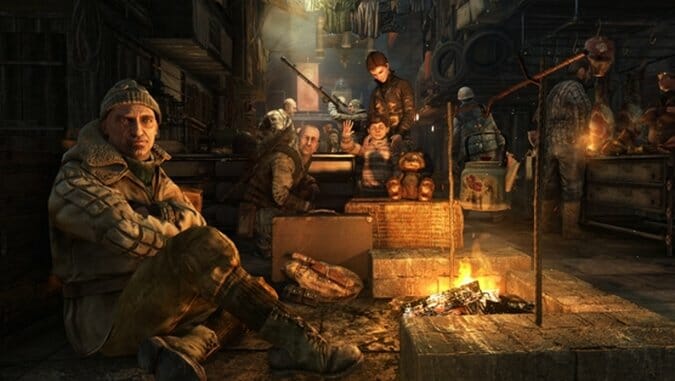
In a slew of unexceptional and formulaic post-apocalyptic first person shooters, Metro 2033 and its sequel, Metro: Last Light, shine as a stunning examples of incredibly well realized worlds. Kiev-based 4-A games recently remastered both games and released them as Metro Redux. For those who have never played either game, Redux is the best way to experience them.
The two games are based on Dimitry Clukhovsky’s novel Metro 2033, which is set in the subway tunnels of post-apocalyptic Moscow in the year 2033, twenty years after nuclear war decimated the world and left the surface of Moscow uninhabitable. Unlike other post-apocalyptic games like Fallout or Borderlands there is little levity in the world of the Metro games, and rightly so—the world is falling to pieces and the few people left have resorted to warring over the few remaining resources.
The two games are mostly made up of treks between small settlements in the tunnels which sometimes require brief trips to the surface. These journeys are difficult because of confrontations with warring parties and mutants and the fact that you are armed with meager equipment and low quality ammunition. When forced to the surface, players are confronted with a larger and more fierce contingent of mutant enemies as well as the added tension of wearing a gas mask. The gas mask uses filters that run out over time forcing players to either move very quickly or scavenge for extra filters. While in the tunnels, players are often forced to navigate with a flashlight that must be charged with crank. Both 2033 and Last Light excel at placing players in tense situations in which they must carefully manage their resources..
Time in the tunnels is so eerie and chaotic that the peaceful moments in various settlements are a welcome respite from the madness. In each settlement you are free to wander around for as long as you like and listen to the stories of the survivors. There is very little joy in these settlements, ravaged as they are by tragedy and brutality. And yet in the midst of this harsh world these survivors fight to preserve truth and beauty. In 2033 players will come upon groups of people huddled around a fire listening to a man play Russian folk songs on a guitar. In Last Light you will find a man making shadow puppets and explaining the difference between animals like birds and elephants from the mutant demons the children of the Metro are accustomed to. Such moments breath life into the Metro by treating the game’s citizens as human beings struggling to preserve art and culture in a world where there is very little beauty.The Metro games care about their worlds more deeply than most first person shooters.
It is important to note, however, that 2033 came out in 2010, and Last Light is barely a year old, which brings up the question of whether or not these games are worthy of being remastered. Having played both games on PC prior to Redux, I can say that the remaster of 2033, a game that came out over four years ago, is impressive. The lighting is much more nuanced and dynamic and the control scheme has been updated to match that of Last Light. Additionally, a few mechanics from Last Light have been added to 2033, like recharging flashlights, and my favorite, the gas mask wipe mechanic, where players must wipe viscera from their gas mask to unobscure their view. When playing Last LIght Redux, however, I was unable to really tell how the game had been graphically improved. The game does come with Ranger mode, a mode that caused some controversy when it was not included in Last Light’s original release but was offered as DLC.
The primary mechanic justification 4-A Games has given for the remaster is the option of two different gameplay modes in each game: Survival and Spartan. Survival aligns more closely with the original design of 2033 by giving players less ammo, limiting supplies and presenting players with tougher A.I. Spartan mode aligns more closely with the original design of Last Light by giving players more resources and providing a more action oriented experience.
Playing Metro 2033 in Spartan mode, however, mutes its most interesting element. 2033 gives players the choice between using high quality, prewar ammunition or lower grade ammo. The higher grade ammo doubles as the players currency with which to purchase supplies and weapons, creating a constant tension in how the player utilizes resources. While playing in Spartan mode, I rarely found myself thinking about this balance as ammo was not in short supply. The careful resource management in 2033 coincided nicely with the game’s desolate setting and forced players to take careful note of the game world. What makes Metro 2033 special is the detail with which 4A Games created its world, and Spartan mode actually discourages players from taking note of that detail. Playing Last Light in survival mode, however, was a delight—I found myself sneaking past large groups of enemies without firing a single shot and utilizing the environment more thoughtfully.
While those who played the original versions of 2033 and Last Light on PS3 or Xbox 360 will certainly be impressed by the facelift both games have received on next gen consoles, there simply isn’t enough new content in the Redux versions of either game to justify the cost. For those who haven’t played either game, the Redux versions offer marked improvements on two games that invite players to thoughtfully engage with a deeply broken yet deeply human world.
Metro Redux was developed by 4A Games and published
by Deep Silver. It is available for the Playstation 4, Xbox One and PC.
Drew Dixon is the editor-in-chief of Game Church. He also edits for Christ and Pop Culture and writes about videogames for Think Christian. Follow him on Twitter @drewdixon82.
